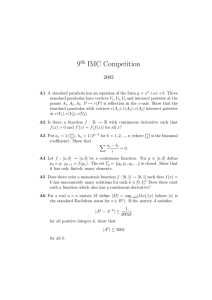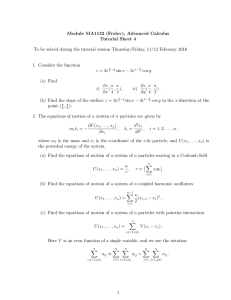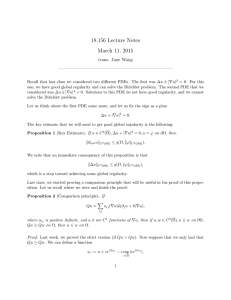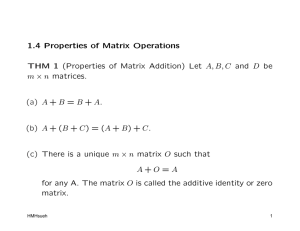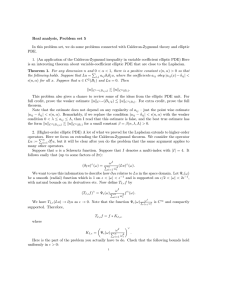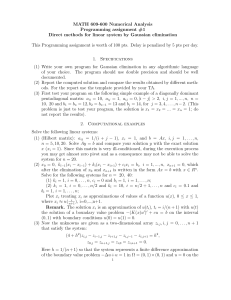EXACT CONTROLLABILITY FOR TEMPORALLY WAVE EQUATION
advertisement
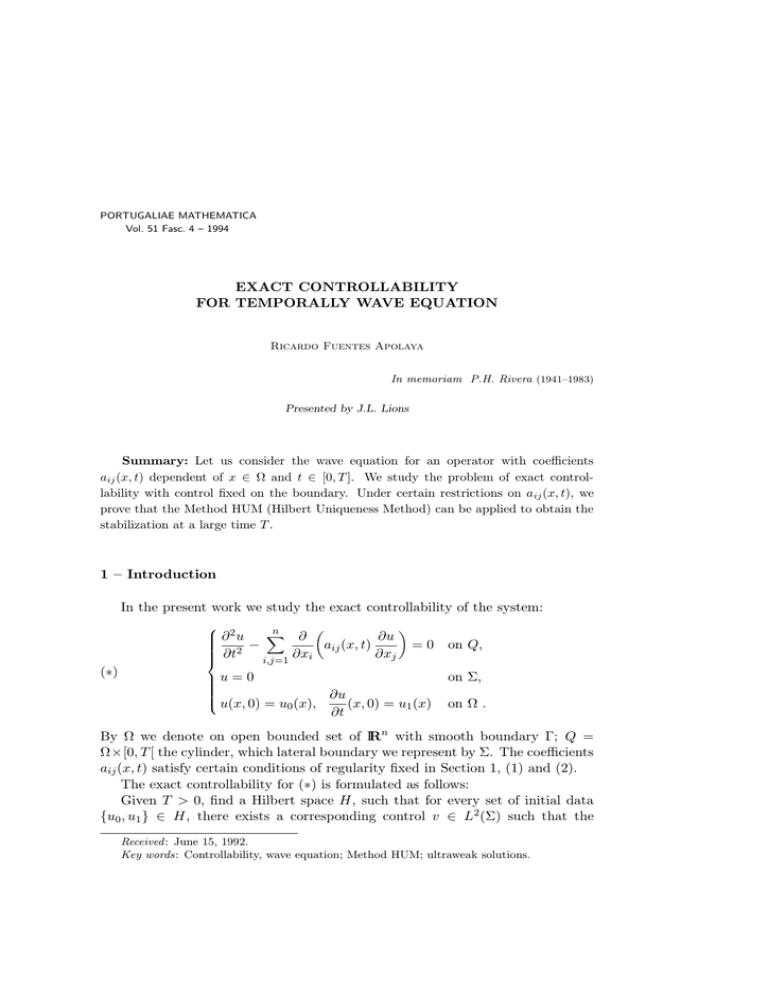
PORTUGALIAE MATHEMATICA
Vol. 51 Fasc. 4 – 1994
EXACT CONTROLLABILITY
FOR TEMPORALLY WAVE EQUATION
Ricardo Fuentes Apolaya
In memoriam P.H. Rivera (1941–1983)
Presented by J.L. Lions
Summary: Let us consider the wave equation for an operator with coefficients
aij (x, t) dependent of x ∈ Ω and t ∈ [0, T ]. We study the problem of exact controllability with control fixed on the boundary. Under certain restrictions on a ij (x, t), we
prove that the Method HUM (Hilbert Uniqueness Method) can be applied to obtain the
stabilization at a large time T .
1 – Introduction
In the present work we study the exact controllability of the system:
(∗)
2
µ
¶
n
X
∂u
∂
∂ u
−
aij (x, t)
=0
2
∂xi
∂xj
∂t
i,j=1
u=0
u(x, 0) = u0 (x),
∂u
(x, 0) = u1 (x)
∂t
on Q,
on Σ,
on Ω .
By Ω we denote on open bounded set of IRn with smooth boundary Γ; Q =
Ω×[0, T [ the cylinder, which lateral boundary we represent by Σ. The coefficients
aij (x, t) satisfy certain conditions of regularity fixed in Section 1, (1) and (2).
The exact controllability for (∗) is formulated as follows:
Given T > 0, find a Hilbert space H, such that for every set of initial data
{u0 , u1 } ∈ H, there exists a corresponding control v ∈ L2 (Σ) such that the
Received : June 15, 1992.
Key words: Controllability, wave equation; Method HUM; ultraweak solutions.
476
R.F. APOLAYA
solution u = u(x, t) of (∗) satisfies the stabilization condition:
(∗∗)
∂u
(x, T ) = 0
∂t
u(x, T ) = 0,
on Ω .
We solve the problem, using the method HUM (Hilbert Uniqueness Method)
idealized by J.L. Lions in 1986, [4]. He studied, initially, the system (∗) for
the case aij (x, t) = 1 if i = j and zero if i 6= j, that is, the case of −∆. In
[4] he studied the case with a coefficient a(t), that is, the operator is −a(t) ∆,
with a(t), a0 (t) ∈ L∞ (IR) and a(t) ≥ a0 > 0, a0 (t) ≥ 0 for t > 0. In this case
Lions [4] proved that we have exact controllability. In Rivera [7] he obtained a
weakest condition, that is, it is sufficient that a(t) is monotonous on some interval
T0 ≤ t ≤ T1 such that
p
R kak∞
T − T0 >
,
a0
R constant .
In the general case aij (x), depending only on x ∈ Ω, Komornik [2] obtained
exact controllability of (∗) with certain regularity on aij (x), plus the following
technical condition:
Exists 0 < δ < 1 such that
(1 − δ) aij (x) ξi ξj −
1 ∂
(aij (x)) mk ξi ξj ≥ 0
2 ∂xk
for all ξ ∈ IRn and x ∈ Ω. For mk look Section 1 in the present work.
Our objective in this work, is to solve the problem of exact controllability for
(∗), in the general temporally case, that is, aij (x, t), x ∈ Ω, t ∈ [0, T ].
We divide the work in four sections. In Section 1 we fix the notation and
do the assumptions. In Section 2 we prove that under convenient hypothesis on
aij (x, t), the method HUM works very well for (∗). The Sections 3, 4 contains
the proofs of the results on the existence and regularity used in the Section 2.
1 – Notations and terminology
By IRn we represent the real Euclidean space of dimension n. Fix x0 , any
point of IRn , and consider the vector
m(x) = x − x0 = (xk − x0k ) = (mk )1≤k≤n .
Let be
R(x0 ) = kx − x0 kL∞ (Ω)
EXACT CONTROLLABILITY FOR TEMPORALLY WAVE EQUATION
477
the radius of the smallest ball, with center in x0 , containing Ω. Represent by
ν(x) the unit normal vector of Γ directed towards the exterior of Ω. We denote
by:
n
o
Γ(x0 ) = x ∈ Γ | m(x) · ν(x) > 0 ,
n
o
Γ∗ (x0 ) = x ∈ Γ | m(x) · ν(x) ≤ 0 .
Note that m(x)·ν(x) represent the inner product in IRn of the vectors m(x), ν(x).
We also represent:
Σ(x0 ) = Γ(x0 )× ]0, T [ ,
Σ∗ (x0 ) = Γ∗ (x0 )× ]0, T [ .
Throughout this work, we use the summation convention for repeated indexs.
Let A(t) be the linear operator defined by:
∂φ
∂
aij (x, t)
A(t) φ = −
∂xj
∂xi
µ
¶
.
Note that A(t) is a temporally second order operator. We suppose that
(1)
aij ∈ L∞ (0, T ; W 1,∞ (Ω)),
aij (x, t) = aji (x, t),
for all (x, t) ∈ Q, 1 ≤ i, j ≤ n.
There exists a constant α > 0 such that
2
aij (x, t) ξi ξj ≥ αkξk ,
for all ξ ∈ IRn and (x, t) ∈ Q .
With respect to the variable t ∈ [0, T ] assume:
(2)
∂
a0ij =
aij ∈ L1 (0, +∞; L∞ (Ω)),
∂t
aij (·, t) ∈ C 1 (Ω)
00
∞
aij ∈ L (Q),
a.e. in [0, T ],
∂
(a0 ) ∈ L1 (0, +∞; L∞ (Ω)) .
∂xk ij
For technical reasons we also suppose, as Komornik [2], the existence of 0 < δ < 1
such that
(3)
(1 − δ) aij (x, t) ξi ξj −
1 ∂
aij (x, t) mk ξi ξj ≥ 0
2 ∂xk
for all ξ ∈ IRn , (x, t) ∈ Q.
Now we define a0 (t, φ, ψ) as the bilinear form:
(4)
0
a (t, φ, ψ) =
Z
Ω
a0ij
∂φ ∂ψ
dx
∂xi ∂xj
for φ, ψ ∈ H01 (Ω) .
478
R.F. APOLAYA
Denote by
(5)
β(t) = ka0ij (x, t)kL∞ (Ω) ∈ L1 (0, +∞),
Z
1
∂φ ∂φ
P (t) =
2
aij
∂xi ∂xj
Ω
2
T0 = R(x0 ) Cα C12 ;
δ
dx ,
φ ∈ H01 (Ω),
Cα = max{1, 1/α} .
Note that the constant C1 will be fixed in Section 3, (23).
2 – The main result and application of HUM
The answer to the question of exact controllability for (∗) is given by Theorem 2.1 in below. The proof will be given by method HUM.
Theorem 2.1. For T0 given by (5)3 . Let be T > T0 . Then, for each
{y0 , y1 } ∈ L2 (Ω) × H −1 (Ω), exists control v ∈ L2 (Σ), such that the solution
y = y(x, t) of the system:
(6)
satisfies
(7)
00
y + A(t) y = 0
on Q,
y=v
on Σ,
y(0) = y0 , y 0 (0) = y1
on Ω ,
y(x, T ) = 0, y 0 (x, T ) = 0
in Ω .
Proof: It will be given by steps. We use certain results of existence and
regularity of ultraweak solutions proved later in the Section 3.
Step 1. We consider a regular problem. In fact, let be ϕ0 , ϕ1 ∈ D(Ω) and solve
the homogeneous system:
(8)
ϕ00 + A(t) ϕ = 0
on Q,
ϕ=0
on Σ,
ϕ(0) = ϕ0 , ϕ0 (0) = ϕ1
on Ω .
The unique solution ϕ = ϕ(x, t) of (8) satisfies:
(9)
∂ϕ
∈ L2 (Σ) ,
∂ν
cf. Section 3.
EXACT CONTROLLABILITY FOR TEMPORALLY WAVE EQUATION
479
Step 2. Using the solution ϕ of (8) we formulate the following backward problem:
00
ψ + A(t) ψ = 0
∂ϕ
(10)
aij νi νj
ψ=
0
∂ν
on Q,
on Σ(x0 ),
on Σ∗ (x0 ),
ψ 0 (T ) = 0 .
ψ(T ) = 0 ,
The system (10) has a unique ultraweak solution ψ = ψ(x, t) defined by transposition. The Theorem 4.3 Section 4 gives the following regularity:
ψ ∈ C([0, T ]; L2 (Ω)) ∩ C 1 ([0, T ]; H −1 (Ω)) .
(11)
The operator Λ
Given ϕ0 , ϕ1 in D(Ω) we solve (8), obtaining a solution ϕ = ϕ(x, t) satisfying (9). Then we solve the backward problem (10), obtaining y = y(x, t) with
regularity (11). Therefore is well defined the map
Λ : D(Ω) × D(Ω) −→ H −1 (Ω) × L2 (Ω) ,
given by
(12)
Λ{ϕ0 , ϕ1 } = {ψ 0 (0), −ψ(0)} .
Step 3. Multiplying the equation (8)1 by ψ, solution of (10), and integrating
on Q, we get:
(13)
hψ 0 (0), ϕ0 i − (ψ(0), ϕ1 ) =
Z
Σ(x0 )
aij νi νj
µ
∂ϕ
∂ν
¶2
dΣ .
From (12) and (13) we obtain:
(14)
hΛ{ϕ0 , ϕ1 }, {ϕ0 , ϕ1 }i =
Z
Σ(x0 )
aij νi νj
µ
∂ϕ
∂ν
¶2
Let consider in D(Ω) × D(Ω) the quadratic from:
(15)
k{ϕ0 , ϕ1 }k2F
=
Z
Σ(x0 )
aij νi νj
µ
∂ϕ
∂ν
¶2
dΣ .
dΣ .
480
R.F. APOLAYA
This is a seminorm on D(Ω) × D(Ω). In this Section 3 we will prove the following
inequality:
(16)
r1 k{ϕ0 , ϕ1 }k2H 1 (Ω)×L2 (Ω)
0
≤
Z
Σ(x0 )
aij νi νj
µ
∂ϕ
∂ν
¶2
dΣ
≤ r2 k{ϕ0 , ϕ1 }k2H 1 (Ω)×L2 (Ω)
0
for all {ϕ0 , ϕ1 } ∈ D(Ω) × D(Ω). The first inequality implies that k{ϕ0 , ϕ1 }kF is
in fact a norm on D(Ω) × D(Ω) and the both inequality (16) imply that the norm
k{ϕ0 , ϕ1 }kF is equivalent to the norm in H01 (Ω) × L2 (Ω), given by:
(17)
k{ϕ0 , ϕ1 }k2H 1 (Ω)×L2 (Ω)
0
=
Z
2
Ω
|∇ϕ0 (x)| dx +
Z
Ω
|ϕ1 (x)|2 dx .
To prove the first part of inequality (16) we need to fix T > T0 , that is, for
large T .
Let F the closure of D(Ω) × D(Ω) with respect to k kF . Then, for T > T0 ,
the inequality (16) shows that
(18)
F = H01 (Ω) × L2 (Ω)
which dual F 0 is H −1 (Ω) × L2 (Ω).
The operator Λ is continuous with respect to k kF . Then is has a unique
continuous extentions to the closure of D(Ω) × D(Ω), which is F given by (18).
We have
(19)
Λ: F → F0
is coercive, then it is an isomorphism between F and its dual F 0 . It follows
that given {y1 , −y0 } ∈ F 0 = H −1 (Ω) × L2 (Ω) exists a unique {ϕ0 , ϕ1 } ∈ F =
H01 (Ω) × L2 (Ω) such that:
(20)
Λ{ϕ0 , ϕ1 } = {y1 , −y0 } .
Then (12) and (20) says that the solution ψ = ψ(x, t) of the backward system
(20) satisfies:
ψ(0) = y0 , ψ 0 (0) = y1 .
Then, the unique solution ψ of (10), with control v = aij νi νj
solution of (6), then y satisfies the stabilization condition (7).
∂ϕ
∂ν ,
is equal to y
EXACT CONTROLLABILITY FOR TEMPORALLY WAVE EQUATION
481
3 – Inequalities
To prove the inequality (16), we need the following identity, which proof was
given by J.L. Lions [4].
Lemma 3.1. For the weak solution φ = φ(x, t) of (8), it is true the identity:
∂φ
∂φ 2
hk νk dΣ = φ0 ,
hk
∂ν
∂xk
Σ
Z
Z
∂φ ∂φ ∂hk
∂φ ∂φ ∂hk
1
aij
aij
−
+
−
2 Q
∂xi ∂xj ∂xk
∂x
Q
j ∂xk ∂xi
(21)
1
2
Z
aij νi νj
µ
¶¯T
Z
¯
∂hk
¯ +1
|φ0 |2
−
¯
2 Q
∂xk
0
Z
µ
¶
1
2
Q
∂φ ∂φ
∂
(aij )
hk ,
∂xk
∂xi ∂xj
where (hk ) is a vector field in C 1 (Ω).
Lemma 3.2 Let φ = φ(x, t) be weak solution of (8), then we have
Z
Σ(x0 )
aij νi νj
µ
∂φ
∂ν
¶2
dΣ ≤ C k{ϕ0 , ϕ1 }k2H 1 (Ω)×L2 (Ω) .
0
Proof: We define the energy associated to the system (8) as the quadratic
form:
(22)
1
2
E(t) =
Z µ
Ω
|φ0 (t)|2 + aij (x, t)
∂φ ∂φ
∂xi ∂xj
¶
dx .
We used the equality (for the proof cf. J.L. Lions–E. Magenes [5])
2E(t) = 2E0 +
Z
t
a0 (s, φ(s), φ(s)) ds .
0
By the coerciveness hypothesis of [aij ], we now find the basic estimate:
n
X
i,j=1
Integrating in Ω, we get:
Z
whence,
Ω
i
¯
¯¯
¯ ∂φ ¯ ¯ ∂φ
¯¯
∂x ¯ ¯ ∂x
|a0ij | ¯¯
¯
¯
¯ ≤ β(t) aij ∂φ ∂φ .
¯
α
∂xi ∂xj
j
¯
¯¯
¯ ∂φ ¯ ¯ ∂φ
¯¯
∂x ¯ ¯ ∂x
|a0ij | ¯¯
i
j
¯
¯
¯ dx ≤ 2β(t) P (t) ≤ 2β(t) E(t) ,
¯
α
α
E(t) ≤ E0 +
Z
t
0
β(t)
E(s) ds .
α
482
R.F. APOLAYA
From the Gronwall’s Lemma, we obtain
(23)
E(t) ≤ C1 E0 ,
∀ t ∈ [0, T ], E0 = E(0) ,
i.e.,
E(t) ≤ C k{φ0 , φ1 }k2H 1 (Ω)×L2 (Ω) ,
∀ t ∈ [0, T ] .
0
In the identity (21), we consider a vector field (hk ) such as hk νk = 1. We estimate
each term in the right side member of (21). From the definition of Σ(x0 ) and
(23), we obtain
Z
Σ(x0 )
aij νi νj
µ
∂φ
∂ν
¶2
dΣ ≤ C E(t) ≤ C k{φ0 , φ1 }k2H 1 (Ω)×L2 (Ω) .
0
Remark 1. By a similar argument used in (23), we prove:
∀ t ∈ [0, T ], C0 = C1−1 .
C0 E0 ≤ E(t) ,
Lemma 3.3 (Inverse inequality). Let φ = φ(x, t) be weak solution of the
homogeneous problem (8) and T > T0 . Then,
(T − T0 ) E0 ≤ C
Z
where
C=
Σ(x0 )
aij νi νj
µ
∂φ
∂ν
¶2
dΣ ,
R(x0 ) C1
.
δ
Proof: We consider the vector field hk = mk ∈ C 1 (Ω), and we observe that
(24)
∂mk
∂
=
(xk − x0k ) = δjk .
∂xj
∂xj
We write
(25)
(26)
¯T
∂φ
X = φ,
mk ¯¯ ,
∂xk
0
µ
Y =
Z µ
Q
(27)
1
I=
2
Z
¶¯
0
Σ
|φ0 |2 − aij
aij νi νj
µ
∂φ ∂φ
∂xi ∂xj
∂φ
∂ν
¶2
¶
,
mk νk dΣ .
EXACT CONTROLLABILITY FOR TEMPORALLY WAVE EQUATION
483
Substituting (24), (25), (26) and (27) in the identity (21), we obtain the equality
X+
n
Y +
2
Z
Q
aij
∂φ ∂φ
1
−
∂xi ∂xj
2
Z
Q
∂φ ∂φ
∂
(aij ) mk
=I .
∂xk
∂xi ∂xj
We apply the technical hypothesis (3), of Komornik, and obtain:
X+
n
Y +δ
2
Z
Q
aij
∂φ ∂φ
≤I .
∂xi ∂xj
Using the equation (8)1 , we have:
Y = (φ0 , φ) |T0 .
From the above inequality and definition of E(t) we get:
X+
µ
n−δ
Y +δ
2
¶
Z
T
E(t) dt ≤ I .
0
From (25) and (26), we deduce the inequality (cf. [4])
¯
¶ ¯
µ
0
¯
¯
¯X + n − δ Y ¯ ≤ R(x ) (|φ0 |2 + |∇φ|2 ) .
¯
¯
2
2
Applying the coerciveness of [aij ] and (23), we obtain:
¯
¶ ¯
µ
¯
¯
¯X + n − δ Y ¯ ≤ Cα R(x0 ) C1 E0 .
¯
¯
2
(28)
From (28) and Remark 1, it follows:
δ C0 T E0 − 2R(x0 ) Cα C1 E0 ≤ I .
(29)
As an immediate consequence of the definition of Σ(x0 ) and R(x0 ), from (29) it
follows that
δ C0 T E0 − 2R(x0 ) Cα C1 E0 ≤
R(x0 )
2
Z
Σ(x0 )
aij νi νj
µ
∂φ
∂ν
Finally, we obtain
(T − T0 ) E0 ≤
R(x0 ) C1
2δ
Z
Σ(x0 )
aij νi νj
µ
∂φ
∂ν
¶2
dΣ .
¶2
dΣ .
484
R.F. APOLAYA
4 – Concept of ultraweak solutions
In this section we study the concept of ultraweak solution by the transposition
method, J.L. Lions [4] and J.L. Lions–E. Magenes [5]. First of all we proceed
heuristically in order to obtain the natural definition. In fact, let us consider the
nonhomogeneous problem
00
z + A(t) z = 0
(30)
on Q,
z=v
for
z(0) = z0 ,
v ∈ L2 (Σ) ,
(31)
on Σ,
z 0 (0)
= z1
z0 ∈ L2 (Ω) ,
in Ω ,
z1 ∈ H −1 (Ω) .
Suppose f ∈ L1 (0, T ; L2 (Ω)) and consider the homogeneous backward problem:
θ00 + A(t) θ = f
(32)
on Q,
θ=0
θ(T ) = 0,
on Σ,
θ 0 (T )
=0
on Ω .
Multiply both sides of (32) by z, solution of (30), assuming that exists and
integrate on Q. We obtain, formally:
(33)
Z
f z dx dt =
Q
Z
Ω
θ(0) z1 dx −
Z
Ω
θ0 (0) z0 dx −
Z
Σ
aij νi νj
∂θ
v dΣ .
∂ν
The solution θ = θ(x, t) of (32) has the regularity
θ ∈ C 0 ([0, T ]; H01 (Ω)) ∩ C 1 ([0, T ]; L2 (Ω)) .
(34)
Then, (33), obtained formally, can be written:
(35)
Z
Q
f z dx dt = hz1 , θ(0)i − (z0 , θ0 (0)) −
Z
Σ
aij νi νj
∂θ
v dΣ .
∂ν
Given f ∈ L1 (0, T ; L2 (Ω)) we obtain θ = θ(x, t) solution of the backward problem (32), with regularity (34), and then we obtain the right-hand side of (35).
Therefore, we have well defined the mapping S by:
S : L1 (0, T ; L2 (Ω)) → IR
(36)
hS, f i = hz1 , θ(0)i − (z0 , θ0 (0)) −
Z
Σ
aij νi νj
∂θ
v dΣ ,
∂ν
EXACT CONTROLLABILITY FOR TEMPORALLY WAVE EQUATION
485
whence
(37)
³
´
|hS, f i| ≤ C kz1 kH −1 (Ω) + |z0 |L2 (Ω) + kvkL2 (Σ) kf kL1 (0,T ;L2 (Ω)) .
Then S is a linear continuous form on L1 (0,T ;L2 (Ω)), that is, S ∈ L∞ (0,T ;L2 (Ω)),
the topological dual of L1 (0, T ; L2 (Ω)). By Riesz’s representation theorem, exists
unique z ∈ L∞ (0, T ; L2 (Ω)) such that
(38)
hS, f i =
Z
f z dx dt .
Q
Whence by (38) we obtain a unique z, solution of (35) for each f ∈ L1 (0, T ; L2 (Ω)).
This is called transposition method.
Definition 1. We call ultraweak solution of (30), with boundary and initial
data given by (31), a function z ∈ L∞ (0, T ; L2 (Ω)) satisfying:
(39)
Z
Q
f z dx dt = hz1 , θ(0)i − (z0 , θ0 (0)) −
Z
Σ
aij νi νj
∂θ
v dΣ
∂ν
for all f ∈ L1 (0, T ; L2 (Ω)).
Lemma 4.1. The system (30) has only one ultraweak solution z, verifying:
(40)
³
´
kzkL∞ (0,T ;L2 (Ω)) ≤ C kz1 kH −1 (Ω) + |z0 |L2 (Ω) + kvkL2 (Σ) .
Proof: It follows from (36), (37), (38). The uniqueness comes from Du Bois
Raymond’s Lemma.
In the following we obtain regularity of ultraweak solutions. The method
consists in obtaining regularity of ultraweak solution with regular initial and
boundary conditions. By density we obtain the regularity for the non regular
case.
Lemma 4.2 Given {z0 , z1 , v} ∈ H01 (Ω) × L2 (Ω) × H02 (0, T ; H 3/2 (Γ)), exists
a ultraweak solution z of the system (30), with the regularity:
z ∈ C([0, T ]; H 1 (Ω)) ∩ C 1 ([0, T ]; L2 (Ω)) .
(41)
Proof: Let v ∈ H02 (0, T ; H 2 (Ω)) be such that γ0 v = v, where γ0 is the trace
operator. Represent by u the solution of the system:
(42)
u00 + A(t) u = −(v 00 + A(t) v) ∈ L2 (Q)
on Q,
u=0
on Σ,
u(0) = z0 , u0 (0) = z1
on Ω .
486
R.F. APOLAYA
We know that u has the regularity:
u ∈ C([0, T ]; H01 (Ω)) ∩ C 1 ([0, T ]; L2 (Ω)) .
Then,
z = u + v ∈ C([0, T ]; H 1 (Ω)) ∩ C 1 ([0, T ]; L2 (Ω)) .
Theorem 4.3. The system (30) has ultraweak solution z for all {z0 , z1 , v} ∈
L2 (Ω) × H −1 (Ω) × L2 (Σ), such that:
(43)
z ∈ C([0, T ]; L2 (Ω)) ∩ C 1 ([0, T ]; H −1 (Ω))
and
(44)
kzkL∞ (0,T ;L2 (Ω)) + kz 0 kL∞ (0,T ;H −1 (Ω)) ≤
³
´
≤ C |z0 |L2 (Ω) + kz1 kH −1 (Ω) + kvkL2 (Σ) .
Proof: We will prove by density. In fact, let us consider {z0µ , z1µ , vµ } ∈
H01 (Ω) × L2 (Ω) × H02 (0, T ; H 3/2 (Γ)) such that
(45)
z → z0
0µ
in L2 (Ω),
z1µ → z1
in H −1 (Ω),
vµ → v
in L2 (Σ) .
Denote by v µ ∈ H02 (0, T ; H 2 (Ω)) the function that vµ = γ0 v µ . We have the
problem
(46)
00
z + A(t) zµ = 0
µ
zµ = v µ
z (0) = z , z 0 (0) = z
µ
0µ
1µ
µ
on Q,
on Σ,
on Ω .
We have, from (41) the regularity for zµ ultraweak solution of (46):
zµ ∈ C([0, T ]; H 1 (Ω)) ∩ C 1 ([0, T ]; L2 (Ω)) .
From the linearity of the system (30), it follows that zµ − z is ultraweak solution
of (30), for the initial condition z0µ −z0 , z1µ −z1 , and boundary conditions vµ −v.
Applying the estimate (40) zµ − z and let µ → ∞, we obtain
zµ → z
in L∞ (0, T ; L2 (Ω)) .
We obtain z ∈ C([0, T ]; L2 (Ω)) because zµ ∈ C([0, T ]; L2 (Ω)).
EXACT CONTROLLABILITY FOR TEMPORALLY WAVE EQUATION
487
Let us now prove that z 0 ∈ C([0, T ]; H −1 (Ω)). In this step of the proof we
have some difficulty motivated by the dependence of the time t. We know that:
0
(47)
hz , f i = −
Z
z f 0 dx dt ,
f ∈ D(Q) .
Q
By hypothesis, z is ultraweak solution of (30), defined by (39). Then z 0 satisfies:
0
(48)
0
hz , f i = (z0 , θ (0)) − hz1 , θ(0)i +
Z
Σ
aij νi νj
∂θ
v dΣ ,
∂ν
where θ is solution of the system:
θ00 + A(t) θ = f 0
(49)
on Q,
θ=0
θ(T ) = 0,
on Σ,
θ 0 (T )
=0
on Ω .
If we prove the inequality
¯ ¯
¯ ∂θ ¯
|θ (0)|L2 (Ω) + kθ(0)kH 1 (Ω) + ¯¯ ¯¯
0
∂ν
0
L2 (Σ)
≤ C kf kL1 (0,T ;H 1 (Ω)) ,
0
where θ is solution of (49) and f ∈ L1 (0, T ; H01 (Ω)), we obtain:
³
´
|hz 0 , f i| ≤ C |z0 |L2 (Ω) + kz1 kH −1 (Ω) + kvkL2 (Σ) kf kL1 (0,T ;H 1 (Ω))
that is, z 0 ∈ L∞ (0, T ; H −1 (Ω)) and
(50)
0
´
³
kz 0 kL∞ (0,T ;H −1 (Ω)) ≤ C |z0 |L2 (Ω) + kz1 kH −1 (Ω) + kvkL2 (Σ) .
From this inequality we use the same argument used to prove the regularity
z ∈ C([0, T ]; L2 (Ω)) in order to obtain z 0 ∈ C([0, T ]; H −1 (Ω)).
We consider first, f ∈ D(Q) and by density we obtain the case f ∈ L1 (0,T ;H01 (Ω)).
We consider the system:
(51)
Z
00
y
+
A(t)
y
−
y=0
y(T ) =
y 0 (T )
T
A0 (s) y(s) ds = f
t
on Q,
on Σ,
=0
on Ω .
It follows that (51) has strong solution, i.e., almost everywhere in Q. The derivative of the solution is equal to the solution of (49), then y 0 (t) ∈ H01 (Ω)∩H 2 (Ω).
Whence y ∈ C([0, T ]; H01 (Ω) ∩ H 2 (Ω)). Multiply (51), by A(t) y 0 and integrate on
Q. We obtain:
(52)
ky 0 (0)k + |y 00 (0)| ≤ Ckf kL1 (0,T ;H 1 (Ω)) .
0
488
R.F. APOLAYA
By the identity (21) for the solution of (49) with appropriate estimates and the
hypothesis on aij , we obtain
(53)
° °
° ∂θ °
° °
° ∂ν °
L2 (Σ)
≤ C kf kL1 (0,T ;H 1 (Ω)) .
0
From (52) and (53) we obtain the proof of z 0 ∈ C([0, T ]; H −1 (Ω)).
ACKNOWLEDGEMENTS – The author thanks Professor L.A. Medeiros and
M. Milla Miranda for their constant encouragement and useful suggestions.
BIBLIOGRAPHY
[1] Ho, L.F. – Observabilité frontière de l’équation des ondes, C.R. Acad. Sc. Paris,
302 (1986), 443–446.
[2] Komornik, V. – Exact controllability in short time for the wave equation, Ann.
Inst. Henri Poincaré, 6(2) (1989), 153–164.
[3] Lions, J.L. – Contrôle optimal des systèmes gourvenès par des équations aux
dérivées partielles, Dunod, Paris, 1968.
[4] Lions, J.L. – Exact Controllability-Stabilization and Perturbations for distributed
systems, J. Von Neumann Lecture, Boston 1986, SIAM Review, March 1988,
pp. 1–68.
[5] Lions, J.L. and Magenes, E. – Problémes aux limites non homogènes et applications, Vol. 1 et 2, Dunod, Paris, 1968.
[6] Medeiros, L.A. – Remark on exact control for variable coefficients, IM-UFRJ,
33o¯ Seminário Brasileiro de Análise, Rio de Janeiro, RJ, 1991.
[7] Rivera, J.M. – Exact controllability coefficient depending on the time, SIAM
Control and Optimizations, 28 (1990), 498–501.
[8] Zuazua, E. – Controlabilidad exacta y estabilización de la ecuación de ondas, Texto
de Métodos Matemáticos, 23, IM-UFRJ, 1990.
Ricardo Fuentes Apolaya,
Instituto de Matemática – U.F.F., Departamento de Análise,
Rua S. Paulo, s/n, 24210 Niterói, RJ – BRASIL

![1. Let R = C[x].](http://s2.studylib.net/store/data/010491179_1-9a9c70e395518f466f652079f02ae14a-300x300.png)


